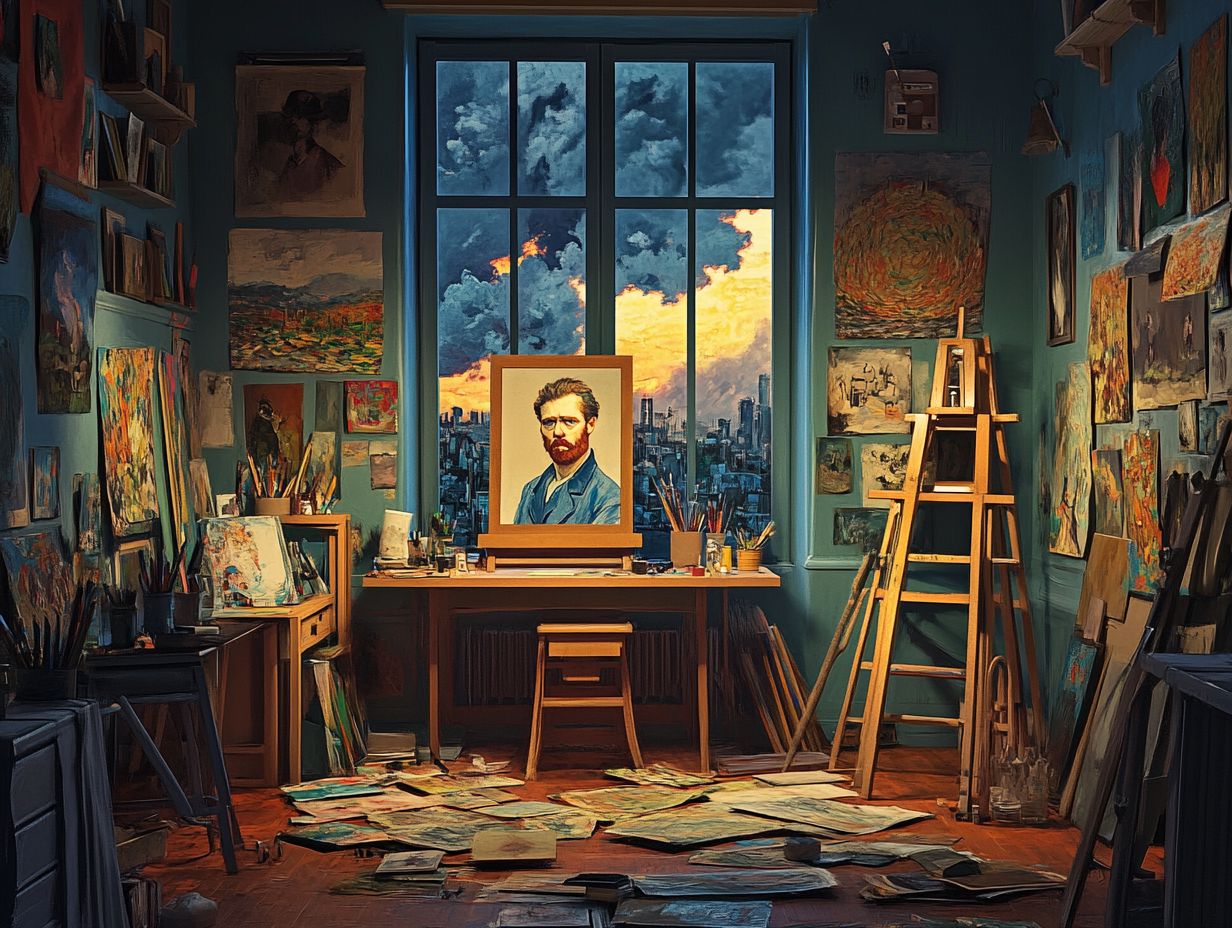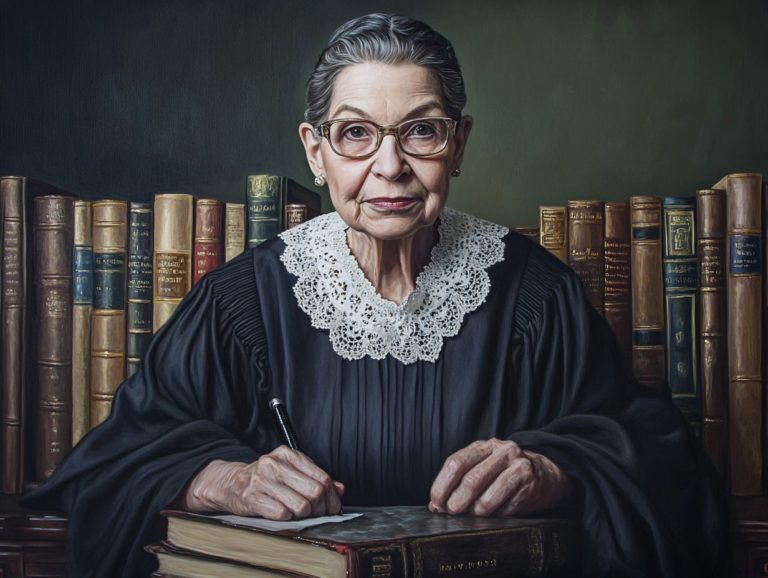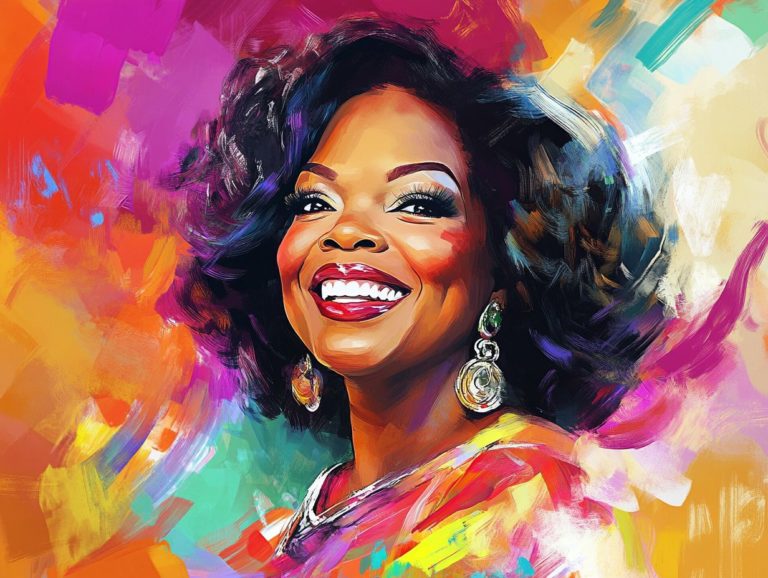The Life of Vincent van Gogh: An Artist’s Struggle
Vincent van Gogh s life unfolds as a captivating journey, rich with profound creativity and deeply personal struggles. Dive deep into the challenges he faced and discover the bold techniques that set him apart!
From his formative years, shaped by family dynamics, to the pivotal influences that ignited his artistic ambitions, van Gogh s story is as compelling as the masterpieces he created. As you delve into the challenges he faced, including his battles with mental health and their impact on his art, you ll uncover the innovative techniques that distinguished him from his contemporaries.
Reflecting on his enduring legacy, you’ll also encounter the misconceptions that often surround this iconic figure in modern art. Discover the intriguing man behind the canvas and gain a deeper appreciation for his remarkable journey.
Contents
- Key Takeaways:
- Early Life of Vincent van Gogh
- Struggles and Mental Health
- Artistic Style and Techniques
- Legacy and Impact
- Frequently Asked Questions
- What was the early life of Vincent van Gogh like?
- How did Vincent van Gogh start his career as an artist?
- What challenges did Vincent van Gogh face as an artist?
- Did Vincent van Gogh’s mental health affect his paintings?
- How did the public respond to Vincent van Gogh’s art during his lifetime?
- What is the legacy of Vincent van Gogh’s life and art?
Key Takeaways:

- Vincent van Gogh faced financial hardships early on, shaping his unique artistic voice.
- Throughout his life, van Gogh battled mental illness, impacting both his personal and professional life as well as his artistic style.
- Despite these challenges, van Gogh’s innovative artistic techniques and bold use of color left a lasting mark on modern art, inspiring countless artists today.
Early Life of Vincent van Gogh
Vincent van Gogh, a titan of Post-Impressionism (a movement that followed Impressionism, focusing on more abstract and symbolic content), entered the world on March 30, 1853, into a family steeped in Dutch heritage. His formative years were enriched by the nurturing guidance of his parents and the unwavering support of his younger brother, Theo van Gogh.
Theo would become an essential pillar in Vincent s life as he traversed the rocky terrain of artistic brilliance. Living in the Borinage, a coal-mining area, provided Vincent with deep insights into the struggles and resilience of working-class individuals, ultimately shaping the themes and vision that would define his remarkable body of work.
Family Background and Childhood
Vincent van Gogh’s family background was a tapestry woven with artistic and intellectual influences, thanks to parents who cultivated a profound appreciation for art and literature in their children. His father, a minister, engaged deeply with theology and the written word, while his mother, an artist in her own right, actively engaged the family in creative pursuits.
This supportive atmosphere sparked Vincent’s passion for painting and fostered an unbreakable bond with his brother, Theo. Their close relationship became a cornerstone of emotional support throughout Vincent’s tumultuous life. Early moments, like his mother encouraging him to sketch the countryside surrounding their home, ignited a passion that would ultimately blossom into masterpieces reflecting his unique perspective of the world.
These familial influences profoundly shaped his artistic journey, instilling a sense of purpose that resonated powerfully in his later works.
Early Career and Influences
Vincent van Gogh’s early career unfolds as a tumultuous journey, influenced by various experiences, particularly his time as an art dealer. This role exposed him to a rich tapestry of artistic styles and movements that would shape his understanding of art.
During this formative period, he developed a keen appreciation for Impressionism and Post-Impressionism, diving into the vibrant works of artists like Gauguin. This exposure ignited his passion for painting, compelling him to experiment with color and brushwork.
As he refined his artistic techniques, his early works began to showcase a distinctive blend of emotional depth and bold, expressive strokes. The influence of key figures on his evolving style was profound, guiding his vision as he transitioned from an art dealer to a prolific painter.
This transformation ultimately paved the way for the masterpieces that would define his legacy. Explore van Gogh s masterpieces today and witness the magic of his artistic journey!
Struggles and Mental Health

Vincent van Gogh s life was profoundly shaped by his battles with mental illness, which influenced both his personal experiences and his artistic creations. Throughout his tumultuous journey, he encountered numerous challenges, including episodes of depression and anxiety.
This struggle ultimately led him to seek refuge in an asylum in 1889, where he produced some of his most iconic works, including striking self-portraits and breathtaking landscapes. These experiences reveal the depths of his mental challenges and create an intimate connection between his art and his inner turmoil.
Challenges in Personal and Professional Life
Vincent van Gogh faced a myriad of challenges throughout his life, both personal and professional, arising from his strong desire to express himself through art amidst a backdrop of constant rejection.
Financial instability was a constant shadow; he often struggled to support himself and heavily relied on his brother Theo s financial support. This dependence strained their relationship, particularly when Vincent s passionate dedication resulted in erratic behavior and periods of deep despair.
Galleries frequently overlooked his work, deeming it too unconventional, which intensified his sense of isolation. Yet, his struggles fueled his creativity, transforming pain into remarkable art.
The complexity of his relationship with Theo served as both a lifeline and a burden, deeply shaping his distinctive artistic voice as he sought solace on the canvas.
Impact of Mental Illness on Art
The impact of mental illness on Vincent van Gogh’s art is profound, as his emotional struggles seeped into his vivid and expressive creations. These battles not only influenced his choice of color but also shaped his dynamic brushwork, resulting in a unique style that resonates deeply with viewers.
Take “The Starry Night,” for example. The swirling skies reflect a sense of turbulence and unrest, mirroring the artist’s internal chaos. In “Sunflowers,” the bold yellows and blues convey a complex mix of joy and despair, inviting you to delve into his intricate psyche.
This interplay between mental health and artistic expression is evident across numerous works, underscoring how his experiences enriched the emotional depth of his art and offered a window into his world.
Artistic Style and Techniques
Vincent van Gogh’s artistic style captivates with its bold colors and profound emotional depth, firmly situating him in the realms of Post-Impressionism and Expressionism.
Explore his iconic works like ‘Starry Night’ and ‘Sunflowers’; here you will witness innovative techniques that transformed the expression of emotions in art.
Van Gogh’s remarkable ability to capture the essence of his subjects while mirroring his emotional landscape creates a unique artistic voice that still resonates with audiences today.
Innovative Approaches and Influences

Vincent van Gogh is celebrated for his innovative approaches to painting, drawing inspiration from various art movements and seamlessly weaving them into his distinctive style.
His work showcases the profound influence of Impressionism, particularly evident in his vibrant use of color and dynamic brushwork. He embraced a more expressive palette, often highlighting bold yellows, blues, and greens, bringing his subjects to life. For instance, “Starry Night,” with its swirling skies and exaggerated colors, evokes intense emotion and movement, reflecting his inner turmoil.
His pioneering technique of applying paint thickly, known as impasto (a painting technique where paint is applied thickly to create texture), creates remarkable depth, setting his pieces apart from those of his contemporaries. This method allows you to feel the energy and passion behind each stroke, inviting you to experience the artwork on a deeper level.
Legacy and Impact
Vincent van Gogh’s legacy is truly monumental. His profound impact on modern art is acknowledged and celebrated across the global art community. Your appreciation of his unique style marked by bold colors and emotional depth allows you to see how he paved the way for future artistic movements.
Countless artists have drawn inspiration from his work, eager to push the boundaries of expressionism, which focuses on conveying emotional experiences rather than just physical reality. Today, when you visit exhibitions featuring masterpieces like ‘Starry Night’ and ‘Sunflowers’, you not only honor his remarkable contributions but also invite yourself to delve into the beauty and complexity of his artistic vision, enriching your own understanding of art.
Recognition and Influence on Modern Art
Vincent van Gogh stands as a monumental figure in modern art. His enduring influence is evident in the artists and movements that have followed in his wake. His posthumous exhibitions, particularly the groundbreaking showcase at the 1905 Salon d’Automne in Paris, revealed his vibrant palette and emotive brushwork, captivating both critics and audiences.
Various art movements, from Expressionism to Fauvism, sought inspiration from his intense emotionality and unique application of color. Contemporary artists have revisited his techniques, weaving their own narratives into his innovative style. Critics have lauded his remarkable ability to capture the human experience with raw authenticity, solidifying his role as a pioneer in portraying life s ineffable aspects.
This ongoing recognition inspires modern disciplines, as Vincent’s legacy ignites a spirit of exploration and emotional truth in creative expression.
Controversy and Misconceptions
Despite Vincent van Gogh’s celebrated status today, his legacy includes controversy and misconceptions that have woven themselves into the fabric of the art community over the years.
You may often hear people linking his artistic genius primarily to his struggles with mental health. Many people face mental health challenges, just like van Gogh. This narrative can overshadow his profound contributions to art, reducing his legacy to a simplistic tale of madness and despair. The misunderstandings surrounding the circumstances of his untimely death only complicate matters further.
Was it a tragic accident, or did he intentionally take his own life? Such questions haunt art historians and distort your appreciation of his work, perpetuating a cycle of sensationalism that shapes how new generations perceive both his character and his art.
As historians dig deeper into his life, it becomes essential for you to contextualize his struggles within the broader spectrum of the human experience. This approach fosters a more nuanced understanding of his enduring influence, allowing you to engage with his legacy on a richer level.
Frequently Asked Questions

What was the early life of Vincent van Gogh like?
Vincent van Gogh was born on March 30, 1853, in the Netherlands. He grew up in a middle-class family and showed an interest in art from a young age.
How did Vincent van Gogh start his career as an artist?
After working in various jobs, van Gogh decided to pursue art as a career at the age of 27. He enrolled in art schools and started creating his own paintings.
What challenges did Vincent van Gogh face as an artist?
Van Gogh struggled with mental and emotional instability throughout his life. He also faced rejection and criticism from the art community, which affected his self-confidence and success as an artist.
Did Vincent van Gogh’s mental health affect his paintings?
Yes, van Gogh’s mental health greatly influenced his art. During his periods of struggle, his paintings became darker and more chaotic, reflecting his inner turmoil.
How did the public respond to Vincent van Gogh’s art during his lifetime?
Van Gogh’s art was not well-received during his lifetime, and he only sold one painting. However, after his death, his work gained recognition and is now considered some of the most valuable and influential in art history.
What is the legacy of Vincent van Gogh’s life and art?
Vincent van Gogh’s life and art have made a significant mark on the world of art. His vibrant colors and emotional brush strokes continue to inspire artists and fans alike.
Van Gogh’s determination to create, even in the face of personal struggles, showcases his passion. This legacy fuels creativity and passion in the art community today.




